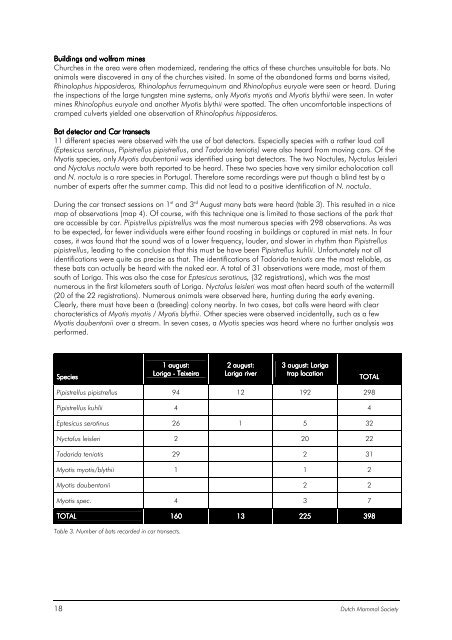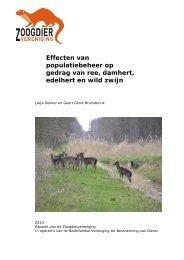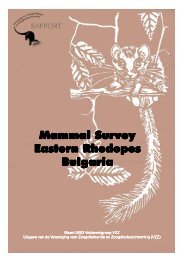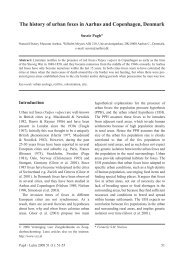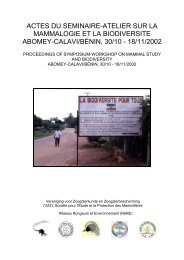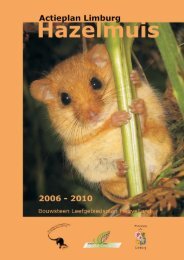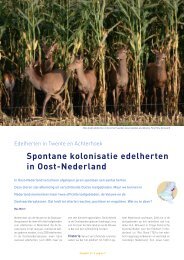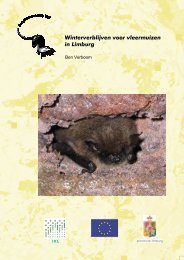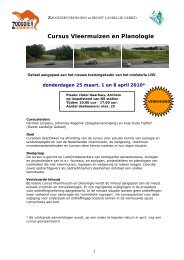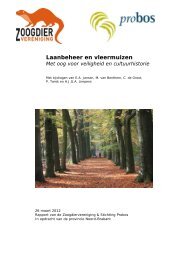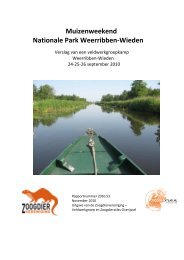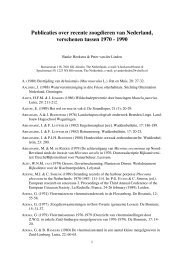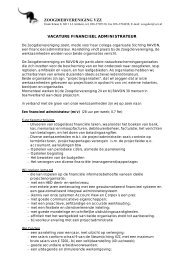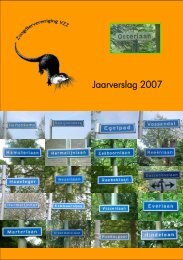mammal survey serra da estrela portugal - De Zoogdiervereniging
mammal survey serra da estrela portugal - De Zoogdiervereniging
mammal survey serra da estrela portugal - De Zoogdiervereniging
Create successful ePaper yourself
Turn your PDF publications into a flip-book with our unique Google optimized e-Paper software.
Buildings and wolfram minesChurches in the area were often modernized, rendering the attics of these churches unsuitable for bats. Noanimals were discovered in any of the churches visited. In some of the abandoned farms and barns visited,Rhinolophus hipposideros, Rhinolophus ferrumequinum and Rhinolophus euryale were seen or heard. Duringthe inspections of the large tungsten mine systems, only Myotis myotis and Myotis blythii were seen. In watermines Rhinolophus euryale and another Myotis blythii were spotted. The often uncomfortable inspections ofcramped culverts yielded one observation of Rhinolophus hipposideros.Bat detector and Car transects11 different species were observed with the use of bat detectors. Especially species with a rather loud call(Eptesicus serotinus, Pipistrellus pipistrellus, and Ta<strong>da</strong>ri<strong>da</strong> teniotis) were also heard from moving cars. Of theMyotis species, only Myotis <strong>da</strong>ubentonii was identified using bat detectors. The two Noctules, Nyctalus leisleriand Nyctalus noctula were both reported to be heard. These two species have very similar echolocation calland N. noctula is a rare species in Portugal. Therefore some recordings were put though a blind test by anumber of experts after the summer camp. This did not lead to a positive identification of N. noctula.During the car transect sessions on 1 st and 3 rd August many bats were heard (table 3). This resulted in a nicemap of observations (map 4). Of course, with this technique one is limited to those sections of the park thatare accessible by car. Pipistrellus pipistrellus was the most numerous species with 298 observations. As wasto be expected, far fewer individuals were either found roosting in buildings or captured in mist nets. In fourcases, it was found that the sound was of a lower frequency, louder, and slower in rhythm than Pipistrelluspipistrellus, leading to the conclusion that this must be have been Pipistrellus kuhlii. Unfortunately not allidentifications were quite as precise as that. The identifications of Ta<strong>da</strong>ri<strong>da</strong> teniotis are the most reliable, asthese bats can actually be heard with the naked ear. A total of 31 observations were made, most of themsouth of Loriga. This was also the case for Eptesicus serotinus, (32 registrations), which was the mostnumerous in the first kilometers south of Loriga. Nyctalus leisleri was most often heard south of the watermill(20 of the 22 registrations). Numerous animals were observed here, hunting during the early evening.Clearly, there must have been a (breeding) colony nearby. In two cases, bat calls were heard with clearcharacteristics of Myotis myotis / Myotis blythii. Other species were observed incidentally, such as a fewMyotis <strong>da</strong>ubentonii over a stream. In seven cases, a Myotis species was heard where no further analysis wasperformed.Species1 august:Loriga - Teixeira2 august:Loriga river3 august: Lorigatrap locationTOTALPipistrellus pipistrellus 94 12 192 298Pipistrellus kuhlii 4 4Eptesicus serotinus 26 1 5 32Nyctalus leisleri 2 20 22Ta<strong>da</strong>ri<strong>da</strong> teniotis 29 2 31Myotis myotis/blythii 1 1 2Myotis <strong>da</strong>ubentonii 2 2Myotis spec. 4 3 7TOTAL 160 13 225 398Table 3. Number of bats recorded in car transects.18 Dutch Mammal Society


